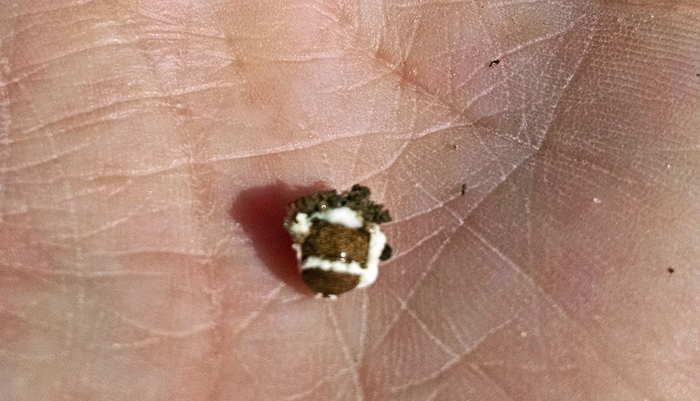Field days are meant for education. They were designed to demonstrate experiments and techniques. They are interactive and also allow for a lot of networking. On July 22, UF/IFAS Extension hosted a Corn & Soybean Field Day, at the West Florida Research and Education Center in Jay, Florida. It was a great day (albeit a hot day). We had good attendance for a sunny day in between all the rain. We had a great agenda with knowledgeable speakers. But I, for one, learned more during the informal part of the field day.
Our second stop of the morning was our Soybean Variety Demonstration. When we walked through the soybean varieties, we found kudzu bugs. These bugs made their first known appearance in our country, in 2009 in Georgia. They do feed and reproduce on kudzu as their name suggests, but they don’t feed heavily enough to harm that prolific weed. They can feed heavily enough on soybeans to decrease our yields. Normally, a fungal pathogen, Beauveria bassiana, keeps kudzu bug numbers below thresholds. This field was just below threshold, and I didn’t see any kudzu bugs infected with Beauveria bassiana. We will keep an eye on the field and treat if we get 1 immature (nymph) per sweep of the 15-inch sweep net, since these soybeans were entering the post flower stage.
–
At our next stop, we talked about the Corn Variety Demonstration. A walk through the corn revealed rust up to the top leaf. Since the corn is almost fully mature, there is nothing to be done about it. The infection came in late, and we don’t think it will reduce the yield. Fungicide applications should be made at or around tasseling to control rust. There are two types of corn rust that we talk about. First is common rust. It can cause pustules on the upper and lower leaf surfaces. It is more common in moderate temperatures (65-85 degrees F). The pustule color is typically dark orange to brick red. The other rust we talk about was Southern Rust. These pustules are bright orange with yellow halos around them. This fungus prefers warmer temperatures (75-95 degrees F). This rust spreads aggressively and causes yield losses. For more information on Southern Rust and Common Rust in Florida, use the link the following fact sheet: Southern vs. Common Rust in Corn

Common vs. Southern rust lesions on a corn leaf. Credit: Rust Diseases of Corn in Nebraska – Tamara Jackson-Zeims, University of Nebraska
–
Walking through these crop demonstration fields was just as valuable as the presentations that were given at this field day. It’s an added bonus to field days. Come scout fields with our specialists and glean even more knowledge from them.
–
Our next Field Day will be the Extension Farm Field Day, to be held at the WFREC in Jay, on Thursday, August 21, 2025. This event will focus on peanut and cotton production.
- Field Days are for Education– Recap of the WFREC 2025 Corn & Soybean Field Day - July 25, 2025
- Spray Drone Regulations - July 16, 2024
- 2023 WFREC Crop Variety Trial Results - February 2, 2024


